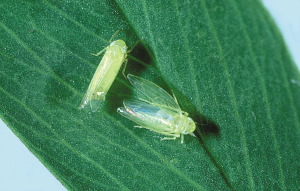
Lucerne leafhoppers
Leafhoppers (also known as jassids) are small sap-sucking insects that rapidly jump (‘hop’) or fly away when disturbed. Colours vary between species and can be anywhere from patterned brown to yellow to a bright green or bluish-green.
Widespread and sporadic, leafhoppers are usually only minor/sporadic pests, although during outbreaks they can be present in very high numbers (>100 per square metre)
The adults of most species are about 3mm long, and wedge-shaped with short antennae. Eggs are laid in slits made in soft plant tissue, and there are usually 5 nymphal stages. During hot weather, a life cycle can be completed in less than two weeks. The wingless nymphs usually resemble the adults but are smaller, paler, and generally slower-moving.
Leafhoppers prefer hot, dry conditions, and in lucerne they are more likely to be present if there are long intervals between harvests.
Damage
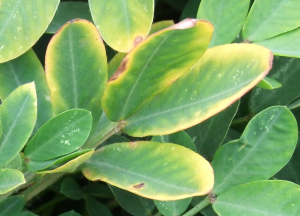
Hopper ‘burn’ in peanuts.
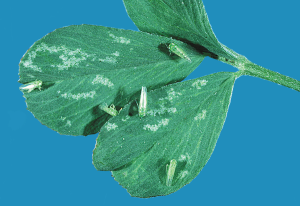
Vegetable leafhoppers and typical leaf stippling.
Leafhoppers are most likely to attack mature leaves from the flowering stage onwards, although they occasionally damage seedlings and new growth. Heavy infestations can cause plant stunting or seedling death. Some leafhopper species cause stippling (tiny pale dots) on leaves that may appear as wiggly lines from a distance. This stippling reduces the photosynthetic capacity of affected leaves, but there is limited data on the impact on crop yield.
Some species inject toxins, causing additional leaf damage, particularly necrosis (yellowing and browning) on the leaf tip, known as ‘hopper burn’, and is particularly noticeable in peanuts.
Very occasionally, leafhopper damage is seen in cotton, (suspected to be caused by lucerne leafhopper).
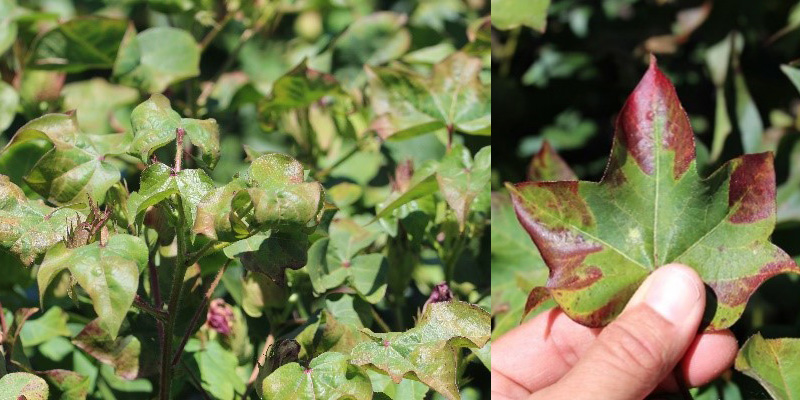
Chlorosis caused by leafhoppers in cotton.
Leafhoppers can also transmit (vector) diseases. Maize leafhopper transmits wallaby ear in maize. Affected plants go dark green, and the leaves become distorted with thickened veins. Other leafhopper species (including brown and spotted leafhoppers) have been implicated in the transmission of a range of viral and phytoplasma diseases.
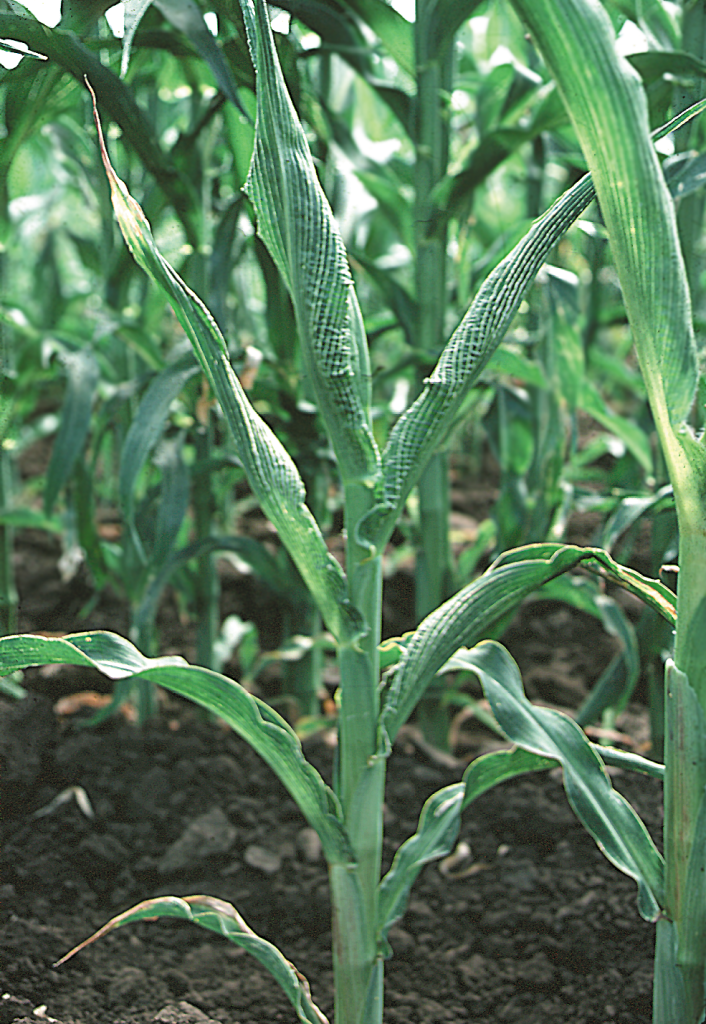
Wallaby ear in maize is transmitted by leafhoppers.
Monitoring and management
On susceptible species, visually check leaves for the distinctive stippling or hopper burn.
Leafhoppers are most easily sampled with a sweep net. Empty captured insects into 70% alcohol (or methylated spirits) or a freezer-safe container to prevent escapes, and express counts as leafhoppers per sweep (one sweep per row).
Examples of thresholds include:
- Peanuts: 30% of leaves have hopper burn symptoms.
- Cotton: 50 leafhoppers/metre row or 50% damage to the upper leaf surface.
- Maize: more than 10 leafhoppers per plant (and wallaby ear is present).
- Pastures: 20 lucerne leafhoppers or 100 vegetable leafhoppers per sweep.
During outbreaks, crops can be rapidly become re-infested after spraying. Unnecessary sprays for leafhoppers will adversely affect beneficial insects and may flare other pests such as helicoverpa or mites. Perimeter sprays may be an option to minimise vector transmission.
Cultural management options include host-plant resistance (some maize hybrid varieties offer resistance to wallaby ear). Maintain good farm hygiene and remove other host plants (e.g. weeds) that may harbor viruses or phytoplasma. For pastures, early cutting or grazing may be an option.
Predatory bugs and spiders will attack leafhoppers, although they will not provide significant control if leafhopper populations are high, or impact vector management.
Common leafhopper species
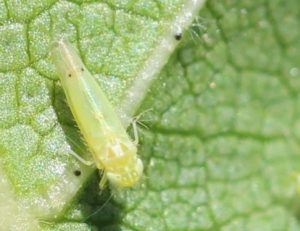 Cotton leafhopper. Note the two dark spots near the back of the wings. Cotton leafhopper (Amrasca terraereginae) is yellow-green and feeds on the upper surface of cotton leaves, causing a pale stippling. |
|
 Lucerne leafhopper (looks similar to cotton leafhopper but has no dark spots on wings). Lucerne leafhopper (Austroasca alfalfa) adults are yellow/yellow-green/bright green and attack lucerne and all summer pulses. Heavy populations can result in leaf yellowing with burnt leaf tips, plant stunting and even death. Lucerne leafhopper is usually not as abundant in summer pulses as the vegetable leafhopper. Crops are at risk at any stage. Injected toxins that cause hopper burn, a yellowing and then a burning or browning (necrosis) of the leaf tips. Peanuts in particular are sensitive to this damage. Severely damaged crops appear to be in full bloom, with the yellowing leaves being mistaken for flowers at a distance. Spray if more than 20% of peanut leaves have hopper burn symptoms. Occasionally cotton can be affected, displaying stunting and leaf chlorosis. Lucerne leafhoppers are easily controlled with systemic pesticides. Well-watered, vigorously growing crops can tolerate damage. Predators such as predatory bugs and spiders will attack leafhoppers. Unnecessary sprays for leafhoppers will adversely affect these and other beneficial insects and may flare other pests such as helicoverpa. |
|
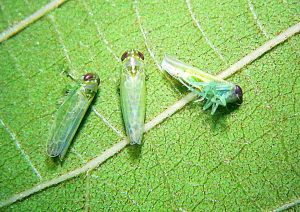 Vegetable leaf hoppers Vegetable leafhopper (Austroasca viridigrisea) adults and nymphs inject toxins, resulting in fine white dots (stippling). Adults are a slightly bluish-green with clear wings extending beyond the abdomen. Their eyes are widely separated and the antennae short. White spotting on the surface of the head and the front section of the thorax enables this species to be readily differentiated from other Austroasca species in Australia. Vegetable leafhoppers attack all summer pulses (including peanuts), leafy vegetables, carrots, potatoes and tomatoes. Dense populations (100 or more per square metre) are frequently encountered in summer pulses, although well-watered, vigorously growing crops can usually tolerate damage. Vegetable leafhopper feeding kills leaf cells and results in small white dots or stippling on the leaves. Trials in drought-stressed peanuts and navy beans have shown that even high vegetable leafhopper populations have little to no effect on yield in these crops. Vegetable leafhoppers are easily controlled with systemic pesticides. |
|
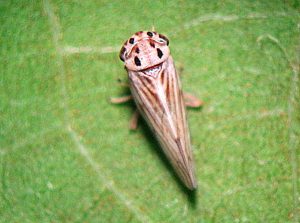 Spotted leafhopper Spotted leafhopper (Austroagallia torrida) is a minor pest of pulses. Hosts include clovers, lucerne, mungbean, pigeon pea, soybean, and some weeds. |
|
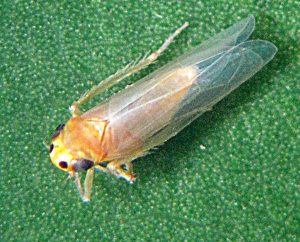 Maize leafhopper Maize leafhopper (Cicadulina bimaculate) is yellow-green to bright green and attacks maize, sorghum and millet. The maize leafhopper is common on maize, particularly in coastal districts, during late summer. Multiple generations can occur on a crop but usually in low numbers. The maize leafhopper feeds by sucking sap. It also transmits wallaby ear mycoplasma. In coastal areas, heavy infestations (more than 15 per plant) produce wallaby ear symptoms in susceptible maize hybrids. Affected plants can be recognised by their dark green colour and thickening of the veins on the underside of the leaves. Inspect crops weekly during the vegetative stage and spray if more than 10 leafhoppers per plant (average) are found and wallaby ear symptoms are present. Note that crops can be rapidly re-infested after spraying. Hybrid varieties offer some resistance to wallaby ear. |
|
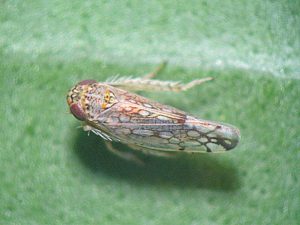 Common brown leafhopper Common brown leafhopper (Orosius orientalis) is a brown patterned leafhopper with a very wide host range that has been identified as the vector for phytoplasma disease. Hosts include pastures, weeds, cotton, oilseeds and pulses including mungbean, soybean, peanuts, pigeon pea and chickpea. |
|
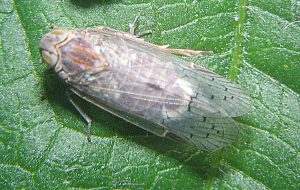 Oteana sp. (is much larger than the other hoppers on this page). The larger Oteana lubra (no common name) looks similar to the common brown leafhopper but is about 10mm long. It has a wide host range and is a minor pest of pulses. |
